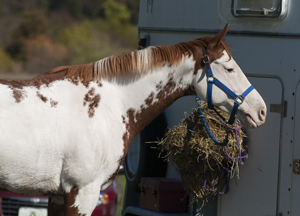If you want to stretch your hay supply with a substitute, know how much hay you’re feeding by weight. “Substitutes don’t come in ‘flake’ measurements, so weigh the hay to have an idea of the appropriate weight to substitute,” says Rhonda Hoffman, PhD, an associate professor of horse science at Middle Tennessee State University in Murfreesboro. She adds that any dramatic changes to a horse’s diet should be done gradually, over a period of one to two weeks, to avoid risk of digestive upset. Here are six substitutes, in her order of preference:

1. Bagged chopped forage. It can replace all of your horse’s hay, if necessary.
2. Hay cubes. Chopped cubed hay (usually alfalfa or timothy or a combination) is another 100-percent replacement. Soak cubes to reduce risk of choke.
3. Hay pellets. Forage that has been dehydrated, ground and cooked to make pellets can technically replace hay. But without any long-stemmed fiber, a horse’s need to chew may lead him to gnaw wood, crib or eat bedding.
4. “Complete” feed. These processed mixtures of grains, forages, vitamins and minerals are designed to be fed without hay. The fiber content should be at least 15 percent (more is better) if no hay is fed. Complete feed has more calories per pound than hay, so feed according to label recommendations and not as a pound-for-pound substitution. However, it will not satisfy a horse’s need to chew.
5. Beet pulp. A great source of highly digestible fiber, it provides about 9 percent protein, similar to some grass hays. But it has a high calcium content (more than alfalfa) and few vitamins, and it won’t satisfy the urge to chew. It may need soaking before feeding to reduce dust and increase palatability. Rhonda recommends feeding no more than 10 pounds (dry weight, before soaking) per day. If you horse is sensitive to high-sugar feeds, look for beet pulp without molasses.
6. Soybean hulls. The hulls–not the soybeans–are high in fiber, relatively digestible, provide about 12 to 14 percent protein and are accepted well by most horses. They can replace all hay but, again, a lack of long-stemmed fiber may lead to wood chewing and similar behavior.
This article originally appeared in the September 2007 issue of Practical Horseman.










